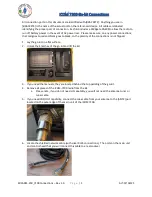
PART FOUR - SERVICE AND MAINTENANCE
SECTION 1 - GENERAL INFORMATION
Rev. 0-201
PRO-series Model C3 Conductivity Transmitter
63
P A R T F O U R - S E R V I C E A N D M A I N T E N A N C E
S
ECTION
1
If a measurement problem exists and you suspect the sen-
sor cable, inspect it for physical damage. If an interconnect
cable is used, disconnect the cable at both ends (sensor
and transmitter) and, using an ohmmeter, check its wires for
continuity and internal shorts.
S
ECTION
2
2.1 Keeping Sensor Clean
2.2 Keeping Transmitter
Calibrated
☞
2.3 Avoiding Electrical
Interference
☞
To maintain measurement accuracy, periodically clean the
sensor. Operating experience will help you determine when
to clean the sensor (typically, monthly intervals). Use the
recommended cleaning procedure described in the GLI
contacting conductivity sensor operating manual.
If the DRY-CAL method (PART THREE, Section 4.3) was
used to calibrate the transmitter, re-calibration is only
needed when replacing the GLI conductivity sensor.
If the
transmitter was calibrated using the 1 POINT SAMPLE
method, you must periodically re-calibrate.
In all cases,
always calibrate the transmitter when replacing the sensor.
NOTE:
If your measuring application requires utmost accu-
racy, GLI offers a re-certification service to verify a
used sensor’s “K” value and temperature “T” factor.
For details, call your local GLI representative or the
GLI Customer Service Department.
Recommendation:
Do not run sensor cable (and intercon-
nect cable, if used) in same conduit with AC or DC power.
Maintenance Tip!
Excess cable should not be coiled
near motors or other equipment that may generate elec-
trical or magnetic fields. Cut cables to proper length
during installation to avoid unnecessary inductive pickup
(“electrical noise” may interfere with sensor signal).
GENERAL INFORMATION
PRESERVING MEASUREMENT ACCURACY





































